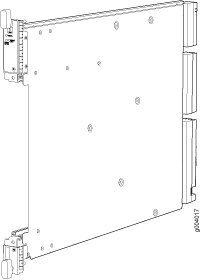SCB-MX Description
The MX Switch Control Board (SCB-MX) provides control plane functions, chassis management functions, and switch plane functions for MX960, MX480, and MX240 routers. It is also a carrier for the Routing Engine which installs directly into a slot on the SCB-MX. See Figure 1.

Software release |
|
SCB-MX Functions |
|
SCB-MX Components |
|
SCB-MX Slot Numbers |
For the MX960:
Note:
On the MX960, either a SCB-MX or a DPC can be plugged into slot 8. A third SCB-MX is used only for switch fabric redundancy. Therefore, if an application does not require switch fabric redundancy, a DPC can be used in slot 8. For the MX480 and MX240 routers:
|
Weight and Dimensions |
|
SCB-MX Fabric Planes and Redundancy |
For MX960 routers:
For MX240 and MX480 routers:
|
SCB-MX Maximum Power Requirements |
185 W at 55° C 160 W at 40° C 155 W at 25° C |
SCB-MX LEDs
Three LEDs on the SCB indicate the status of the SCB. The LEDs, labeled FABRIC ACTIVE, FABRIC ONLY, and OK/FAIL, are located directly on the SCB. Table 1 describes the functions of the SCB LEDs.
Label |
Color |
State |
Description |
|---|---|---|---|
FABRIC ACTIVE |
Green |
On steadily |
Fabric is in active mode. |
FABRIC ONLY |
Green |
On steadily |
SCB-MX operates in fabric-only mode. |
– |
Off |
SCB-MX operates in fabric/control board mode. |
|
OK/FAIL |
Green |
On steadily |
SCB-MX is online. |
Red |
On steadily |
SCB-MX has failed. |
|
– |
Off |
SCB-MX is offline. |
SCB-MX Fabric Plane Scale and Redundancy
Each of the fabric planes on the SCB-MX is able to process 20 Gbps of bandwidth. The MX240 and MX480 use eight fabric planes across two SCB-MXs, whereas the MX960 uses six fabric planes across three SCB-MX’s˙. Because of the fabric plane virtualization, the aggregate fabric bandwidth between the MX240, MX480, and MX960 is different. Refer to Table 2.
SCB-MX |
MX240 |
MX480 |
MX960 |
|---|---|---|---|
PFEs |
12 |
24 |
48 |
SCBs |
2 |
2 |
3 |
Switch Fabrics |
4 |
4 |
6 |
Fabric Planes |
8 |
8 |
6 |
Spare Planes |
4 (1+1 SCB-MX redundancy) |
4 (1+1 SCB-MX redundancy) |
2 (2+1 SCB-MX redundancy) |
Fabric Bandwidth Per Slot |
160 Gbps |
160 Gbps |
120 Gbps |
Interoperability With Routing Engines
Routing Engines |
Maximum Power Requirement |
|---|---|
RE-S-X6-64G RE-S-X6-128G |
110 W |
RE-S-1300 (EOLed) RE-S-2000 (EOLed) RE-S-1800 (all variants) RE-S-2000-4096 (EOL’d) |
90 W |
